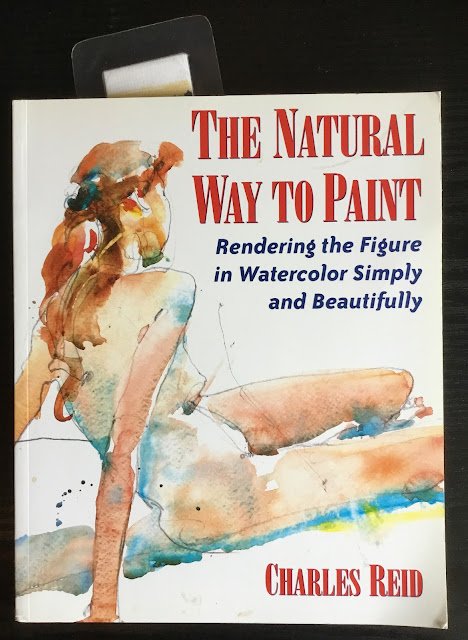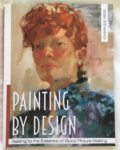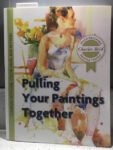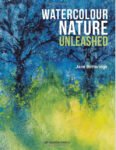Not a Christmas present, this one. It’s a book I’ve been after a while and that I’ve been watching out for using the CamelCamelCamel website, which monitors the prices of books on Amazon. Well, this one became available in December at a reasonable price, so I ordered a copy. It arrived not long after Christmas after a long journey from the USA. It’s a 144 page paperback.
It’s all about figure drawing and, in particular, about Charles’ unique loose figure drawing style. If you don’t like the look of the cover or of any page previews that you can find on the internet, best stay away. Anyway, let’s get down to business. This book has six chapters of various lengths. I’m going to discuss the chapters individually but, to be honest, the book felt like one long journey.
The first chapter was on contour and gesture drawing. Contour drawing was covered brilliantly in another of Charles’ books. There’s more coverage here but from a different viewpoint. A nice example drawing some eyes and some discussion of extending contour drawing to contour painting. There’s a bit on adding shadows to a facial contour drawing where, sadly, the quality of the illustrations is too poor for me to be able to see what’s happening, but the text explains everything. We then go on to gesture drawing, which is illustrated with some excellent worked examples. Charles’ idea of gesture drawing is linking different parts of the body with a single curve – maybe the edge of one arm and of another leg, for example, look like two sections of one long line. I don’t think this is the same as the fast and loose scribbling that Bert Dodson calls contour drawing in his book.
Then we have a chapter on painting techniques and colours. The most useful stuff in this chapter was on how to hold the brush, how to mix colour on the palette and keeping the palette clean (I’m looking at YOU, Liron Yanconsky!). There’s also some early stuff on Charles’ style, talking about painting with spots of colour.
Then we start getting down to the real business with a chapter on getting from silhouettes to 3D form. We start with drawing silhouettes (in more than one colour) and how to make them three dimensional using shadows, colour temperature and colour intensity. We get the first mentions of how to hint at the facial structure by painting shadows in the right places, which is absolutely not the same as painting eyes, noses and mouths. There’s also lots of talk about blending shadows together, even if they’re different colours and both on the body and in the background.
Then there’s a short and sweet chapter on facial features which is absolutely crammed with a valuable tips on painting the eyes, nose and mouth that I’ve not seen anywhere else. And that’s probably because this is all about painting the face in a figure drawing, where less detail is needed than when painting (for example) a head and shoulders portrait.
Then there’s a chapter on demonstrations. This chapter, while reiterating some of the ideas from earlier in the book, also introduces plenty of new ones. In particular, this is where there’s the most discussion on linking together the figure and the background and on using the background to negatively paint the figure. A lot of this chapter, rather than being step by step demonstrations, is just examples of finished works used to illustrate points, which suits me. There are only two actual demonstrations. Both are worded as instructions but they didn’t feel like recipes as there was plenty of wording in the first person, with Charles’ comments on both why he was telling us to do particular things and on how well the paintings were going. So he didn’t raise my hackles at all.
And then the final chapter was on composition and design. Most of this chapter was a series of paintings with commentary from Charles on why he made particular compositional decisions. So not really a set of tips, but more a demonstration of thinking in practice.
The book itself was packed full of tips. It didn’t feel like reading a set of condensed notes like other tip-packed books do. This was more a long story by Charles where the tips just emerged organically and in an easily digestible manner. It’s only when a you’ve read a few pages and start to reflect that you realise just how much he’s giving away. If he was sat in this room painting and talking, I’d be listening to every word he said. And all the words glide down effortlessly like a Baileys & Vienetta – writing like this is an underrated skill.
The book’s all about figure drawing in Charles’ style but that doesn’t mean we all have to copy him. There’s plenty in there that I can incorporate into my own figure paintings (or even landscapes or portraits) with only minor tweaks to my style. On the other hand, I’m itching to try out Charles’ style all in, either with watercolours or with the Artgrafs.
I’d not recommend this, by the way, as a first figure drawing book, pointing people instead to
Huston or
Legaspi, and even then probably only after a more general book on drawing. This is a book for the experienced figure artist wanting to learn more advanced techniques and to explore new styles.
I don’t feel like I’ve eulogised enough about this book. Maybe I’m just knackered from making notes on it and then recording the notes on a flash card app that I can use to throw up random tips from random books. I almost said that reading the book had made me tired too, but that’s definitely not the case. It’s only afterwards when you try to sort through everything without Charles there to guide you that you realise how much there is to sift through. Make no mistakes, this is an excellent book and one that I’ll keep coming back to. I have three of Charles’ books now and they complement each other nicely. It’s like sitting down by the fire to hear his stories for three evenings – different stories each night with only a bit of overlap.
A pleasure to read, inspirational, packed with eye-opening tips. This is a brilliant, brilliant book and is the easiest five palettes that I’ve awarded for a while.
🎨🎨🎨🎨🎨









Leave a Reply